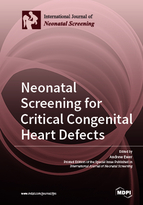Neonatal Screening for Critical Congenital Heart Defects
A special issue of International Journal of Neonatal Screening (ISSN 2409-515X).
Deadline for manuscript submissions: closed (15 January 2018) | Viewed by 49938
Special Issue Editor
Special Issue Information
Dear Colleagues,
Critical congenital heart defects (CCHDs) are potentially life-threatening malformations that remain a significant cause of neonatal mortality and morbidity. Failure to diagnose these condition shortly after birth may result in acute cardiovascular collapse and death.
Identification of CCHDs by routine newborn clinical examination is routine in many countries, but consistently misses over a third, and, although antenatal ultrasound screening can be very effective in early diagnosis, the provision of ultrasound and accuracy of ultrasound screening is highly variable.
As most CCHDs present with mild cyanosis (hypoxaemia), which is frequently clinically undetectable, pulse oximetry is a rapid, simple, painless method of accurately identifying hypoxaemia, which has gained popularity as a screen for CCHD.
This Special Issue of the International Journal of Neonatal Screening, devoted to "Neonatal Screening for Critical Congenital Heart Defects (CCHD)", will consider the evidence for CCHD screening with pulse oximetry, the acceptability and cost-effectiveness of this intervention the additional non-cardiac conditions, which may also be identified, and the international experiences of introducing CCHD screening across the globe.
Prof. Andrew K Ewer
Guest Editor
Manuscript Submission Information
Manuscripts should be submitted online at www.mdpi.com by registering and logging in to this website. Once you are registered, click here to go to the submission form. Manuscripts can be submitted until the deadline. All submissions that pass pre-check are peer-reviewed. Accepted papers will be published continuously in the journal (as soon as accepted) and will be listed together on the special issue website. Research articles, review articles as well as short communications are invited. For planned papers, a title and short abstract (about 100 words) can be sent to the Editorial Office for announcement on this website.
Submitted manuscripts should not have been published previously, nor be under consideration for publication elsewhere (except conference proceedings papers). All manuscripts are thoroughly refereed through a single-blind peer-review process. A guide for authors and other relevant information for submission of manuscripts is available on the Instructions for Authors page. International Journal of Neonatal Screening is an international peer-reviewed open access quarterly journal published by MDPI.
Please visit the Instructions for Authors page before submitting a manuscript. The Article Processing Charge (APC) for publication in this open access journal is 1600 CHF (Swiss Francs). Submitted papers should be well formatted and use good English. Authors may use MDPI's English editing service prior to publication or during author revisions.
Keywords
CCHD screening in USA
CCHD screening in Scandinavia, Australia and China
CCHD screening in UK and Europe
Achieving consensus statement in South and Central America
Variations in screening algorithms—how to decide which to use?
The acceptability of Pulse Oximetry (PO) screening
The cost effectiveness of PO screening
Identification of non-cardiac disorders with PO screening
PO Screening for births at home







